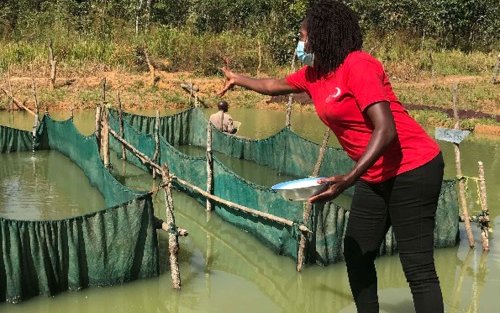Over the last decade, the aquaculture sector in Zambia and Malawi has tremendously grown. The availability of commercial feed companies producing complete commercial feed diets in Zambia has been one of the key factors contributing to the growth of the aquaculture industry. However, the use of commercial feeds among smallholders remains low.
Low usage of complete diet feeds by smallholder farmers has been listed as one of the key constraints to improving the performance of smallholder farmers in the sector, according to the WorldFish report, A review of aquafeed business models and the feed value chain in Zambia and Malawi. The review aims to understand the constraints to the utilization of commercial feeds in Zambia and Malawi, identify existing opportunities for feed in the aquaculture sectors and understand existing aquaculture feed distribution models in the region, to identify lessons learned and their applicability to Zambia and Malawi.
Critical challenges in aquaculture for both Zambia and Malawi include access to quality inputs, particularly seeds and feeds, which account for the most significant proportion of the operational costs in aquaculture. Lack of technical knowledge in better management practices is another critical challenge among smallholders. Besides the perceived cost of purchasing commercial feeds, smallholder fish farmers incur high transport costs, as most of the feed distributors are located far from rural farmers.
In Malawi, local commercial production of floating feeds is currently nonexistent. Feed producers in Zambia and Malawi import most ingredients in fish feeds, which impact the prices of commercial feeds.
Despite the challenges, the following opportunities exist within the fish feed value chain: developing alternative and cheaper fish feeds, private sector engagement to strengthen feed distribution networks, microfinance and credit solutions, and opportunities for harnessing economies of scale within farmer groups and clusters are some of the opportunities that can be tapped into, to develop the fish feed value chain.
There are research gaps that need to be explored in identifying low-cost feed distribution networks. These research gaps include (1) understanding the critical mass of smallholders needed to make it profitable for commercial feed companies to supply feed, (2) segmentation of fish farmers’ profiles to understand their willingness and ability to adopt commercial feeds, (3) understanding the economic returns in the use of commercial feeds under different market scenarios and (4) identifying options for microfinance and access to cash and in-kind credit for the purchase of commercial feeds.
Several feed models, that have been successfully used within the African and Asian regions, can be piloted and tested in Zambia and Malawi. The first model is a microfranchise model using a network of local agro-dealers as agents (aqua-shops), who equally provide technical knowledge and training to smallholders. The second model is a cooperative model using farmer groups and clusters to buy feed in bulk and sell to both members and non-members; alternatively, aggregate feed orders to achieve the critical mass in feed distribution. The third model involves empowering cooperatives to be small-scale feed millers through supporting them with feed milling equipment and training in feed formulation. The different models provide opportunities but also pose challenges depending on the prevailing circumstances.
Download the review below.










